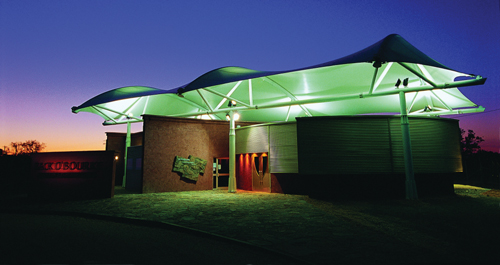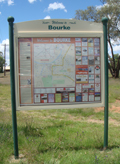
Business Directory and Tourist Guide
discover the real outback nsw
You don’t know Australia until you know Bourke
Bourke Shire comprises a total area of 4.3 million hectares. Over 12,000 hectares are cultivated,
with cotton the predominant crop occupying almost 70% of the improved area, almost all of which
is irrigated.
Bourke is 789km from Sydney and is 107m above sea level. The population of the Shire is 3,095,
and the town is approximately 3,600. Bourke's annual rainfall over the 114 years has averaged 315mm.
Half of this falls over the summer period from December through to March.
Average daily maximum temperatures range from 35 degrees C in summer to 20 degrees in winter.
Daily minimum temperatures range from 20 degrees in summer to 5 degrees in winter. There are also extremes in temperature with 45 degrees common in the summer months, and frosts common in the
winter months.
Wool and sheep have been a major industry in the Bourke District for over a century.
Cotton is a crop
well suited to the climate of the Bourke district and is a major employer of district labour.
In the 1991/92 seasons the long stapled Pima variety was sown in large areas for the first time. Bourke
is one of only a few areas suitable for growing this variety. Pima attracts a significant premium over the
more traditional upland cotton and is an important development in the cotton industry at Bourke.
Other
crops grown in the Bourke District include wheat, rockmelons, grapes, citrus and a large range of
horticultural crops. Over 200,000 kg of honey is produced every year.
Feral animals and Kangaroos: Large number of feral goats and kangaroos are found over most of the Bourke Shire. For primary producers these animals are a major problem, competing for the available
feed with sheep and cattle.
Goat meat is the widely eaten meat around the world. The Bourke Shire has an abundant supply of feral goats and large numbers have been slaughtered in the local abattoirs for export. Kangaroo and pig meat freezers are also located in Bourke.
Recreational facilities are of a high standard, neat parks, an Olympic pool area offer shady retreats: a golf course, sporting ovals and PCYC give plenty of space to relax.
A well equipped hospital and ambulance plus the Royal Flying Doctor Service
in outlying areas ensure efficient help in crises. Countrylink transport companies, schools, TAFE, distance education and local radio
stations 2WEB and 2CUZ all service the town.
TOURIST INFORMATION CENTRE
The best way to really get your bearings in Bourke is to start at the Visitor Information Centre. The friendly staff there will help you with all the necessary information to make your stay enjoyable. The mud maps will enable you to visit all the key sites around town, and the centre can also update you on road conditions during the rainy periods. Phone: (02) 6872 1321 – Fax: (02) 6872 1395
For over 100 years, Bourke has been the centre of a large pastoral industry. The town was established in 1862 as a centre for supplies to surrounding properties and for the export of wool. Mail Coach (Cobb & Co.) Horse, Camel and Bullock Teams provided the original means of transport and this was strongly supported by Paddlesteamers that moved supplies to and from the coast of South Australia.
In 1883 the bridge was built across the Darling River and in 1885 the first rail train came to Bourke. With the advent of motor transport the paddleboats and teamsters gradually were outmoded and today road is the only means of transport.
Bourke became a municipality in 1878 and reached the peak of prosperity in the early 1890's. A period of decline set in after that. However this trend reversed over the last 40 years. The pastoral industry has always dominated Bourke's economy. This situation has been changed by the building of low level weirs on the Darling River and with the development of the cotton industry.SOME GEOGRAPHICAL FACTS
Height above sea level: 110m – Annual rainfall: 330mm
The country surrounding the town, south of the river is alluvial and subject to flood. Predominant treesnear the town are Coolabah. Black Box and Red Gums along the river. For some months the summer heat can be extreme (Bourke holds the record for State's highest temperature 51oC, 125oF, recorded in 1864).
In general, other seasons are delightful. The water storage system has provided a tremendous impact
on the environment and with rapidly changing conditions attracts and supports all sorts of wildlife. The wildflowers in the Lednapper region in springtime are beautiful, whilst visitors are spellbound by the extraordinary colours of sunrise and sunset.
HISTORIC BUILDINGS
Of particular interest is the Court House, built in 1899. This beautiful building is maintained under supervision of the National Trust. The Post Office and Post Office Hotel, The Western Lands and Government Office Building & The Old Catholic Church and Convent, are all over 100 years old.
A STROLL BY THE RIVER
Many pleasant hours can be had spending your way and reliving the history of the old Darling River. During the early days the Darling was a main transport link from Bourke to Adelaide with Paddlesteamers winding there way from Station to Station, Town to Town.
NORTH BOURKE
Follow the Kidman Way in a northerly direction from town, cross the Billabong and River Bridges to North Bourke. Once called West Bourke and a stopping place for Drovers, Teamsters and the like. With the advent of the bridge and motor transport, North Bourke reverted back to a pub and store. The North Bourke Bridge was opened in August 1888 and was the first bridge over the Darling and also the first lift-up bridge in N.S.W.
COTTON GINS
Cotton and Fruit Industry have emerged as alternative production to the traditional pastoral industry. Bourke has two cotton gins that service the area. Fruit grown includes citrus, grapes and melons. Tours of these developments can be arranged through the Visitor Information Centre.
FISHING
The Fishing Reserve is located below the Bourke Weir. There is fishing access at all weirs on the Darling, however before entering private properties visitors should contact the property owner. Please remember – no shooting without permission and take all litter with you. Within the season Cod, Perch and Catfish are regularly caught in the Darling River using yabbies, shrimp and worms for bait. Fishing notes can be obtained from the Visitor Information Centre.
THE DARLING RIVER AND BOURKE
The LOCK AND WEIR was opened in 1897, the lock being 59.5 metres between gates, and 11 metres wide; the weir consisted of 33 moveable shutters on the "Chanoine" system. The lock was once the only one built on the Darling, but many weirs are now in existence.
The WHARF SITE AND PUNT CUTTING – there were earlier temporary wharves, but the last and the biggest was opened in 1898, long after the railway line reached Bourke. Initially the town was a busy port for paddlesteamers operating mainly from Echuca and Morgan, then the wool began to be brought in (to the railhead), motor transport displaced the boats, and the wharf began to decay. The last boat to Bourke arrived in 1931. A replica wharf represents Bourke's link with the River trade.
PLACES OF INTEREST IN AND AROUND BOURKE
FORT BOURKE STOCKADE – "The whole place seemed extremely favourable for the object about which I was most anxious – namely the establishment of a secure depot and place of defence." These words, written by Major Mitchell on his exploration of the Bourke area in 1835, relate to Fort Bourke Stockade, situated about 16 km from Bourke by road or about 10km in a direct line. It was named after His Excellency Governor Bourke, the Governor of the Colony at the time. A replica of the structure was built in 1983 and now serves as a tourist attraction, located on a beautiful water storage near the river.
GUNDABOOKA NATIONAL PARK – discovered by Sturt and Humes party in 1829. The pools and beautiful rock formations take you back more than 40,000 years. Cave sites containing protected Aboriginal Rock Art can be viewed in this area.
MOUNT OXLEY – Discovered by Sturt and Hume in 1828 just prior to the
discovering of the Darling River. It offers spectacular views over 100's of kilometres of outback plains. Permit from the Visitor Information Centre necessary.
BOURKE CEMETERY - Bourke is the resting place of 1991 Australian of the Year, Professor Fred Hollows. Eye Surgeon Fred Hollows developed a commitment to Aboriginal health. He was instrumental in the development of Aboriginal medical centres and the launching of the national trachoma and eye health program. Fred's concern for eye health soon spread and he set up clinics in Bangladesh, Burma, Nepal, Vietnam and in Latin America.
Also in Bourke Cemetery are the graves of several Afghans associated with the camel industry, which ceased in the 1920's.
The graves of two policemen killed on duty (one Const. McCabe, shot by bushranger Captain Starlight in 1868), the grave of local poet F. H. Brown and many other graves of historical interest can be found there.
For more information about any of these interesting, fun, free activities and other great things to see
and do in the Bourke Shire contact the friendly team at the Bourke Visitor Information Centre.
E: info@backobourke.com.au www.visitbourke.com.au
bourke visitor information Centre
Back O’ Bourke Exhibition CentreKidman Way,
Bourke NSW 2840






